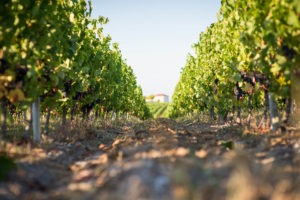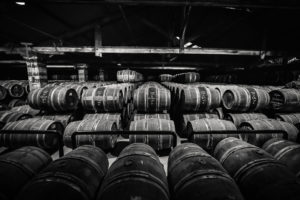Small article about two French regions plagued by discord… One in the West, the other in the East of France. One further South, the other further to the North… Already geographically speaking it’s the opposite ! This is not the same accent, not the same climate and above all… not the same type of wine ! Yet these two wine producing regions are surely the most prestigious on our soil : wines are of a great delicatness and are recognized all around the world ! These areas are the lungs of the wine world which do not necessarily breathe together but who cares, they touch our heart !
Bordeaux and Burgundy, two ‘B’… Bim ! Bam ! Bang! ! We often hear fans of Bordeaux to denigrate Burgundy and Burgundy lovers to spit at Bordeaux… The corks war is declared… But why? How ?
PART 1) ‘When I will grow up, I will be an alcoholic‘ War of the Buttons
Burgundy vs Bordeaux, it is the war of two flavors and of two wine conceptions. When has this discord begun ? Good question which is difficult to clarify.. Certainly for the ancient time ! Can we speak moreover really about war ? I have a feeling that yes. Indeed, as I noted it above, pro Burgundy dislike pro Bordeaux and vice versa. It is necessary to say, objectively, that wines from these regions are radically different ! Let’s see closer the obvious differences between the two B.
• Classification : get ready to burn some neurons !
Bordeaux classification is quite easy… I think : it exists several ones and they take into account quite the quality of the wine. The first one, the most famous, was born in 1855. Emperor Napoleon III asked to Bordeaux brokers to rank the wine estates according to the prices and affinities, (and it’s highly political, let’s not forget it) in order to present a classification during the Universal Exhibition at the same date.
Left bank of Bordeaux: 61 red wines and 27 sweet wines (back in the time dry white wines were not fashionable) were therefore classified. Let’s note that wines of Saint-Emilion and Pomerol are not part of the classification. For red, it’s simple : the 61 Crus are ranked from 1st to 5th Grand Cru Classé. There are a top 5 : 4 Medoc and 1 Pessac Leognan. Small anecdote, there were only 4 first ranked wines at the begining : Château Mouton Rothschild is the only estate that have been able to change its place from second to first in 1973. Finally, for the sweet, Sauternes and Barsac, we find 27 vineyards ranked from the first to second with a single Premier Grand Cru Superior which is the famous Château d’Yquem. Come then 11 first and 15 second.
Ultimately, other subsequent rankings complete the 1855 one which has never moved and, I think, will never move ! Gaps appear nevertheless in this classification : notably absent, wines of the Right Bank but also wines from Graves (only the Château Haut- Brion was ranked first and is part of the Graves region).
In 1953 (then revised again in 1959), the classification of wines of Graves was born to repair this injustice: 7 red wines, 3 white wines and 6 both red and white wines have been ranked. Château Haut- Brion is also the only Château to be part of two classifications. Then in 1954, the classification of the Right Bank (Saint-Emilion finally) has been created : it’s revised every 10 year so allowing to renew the debates… The classification includes two catégories : Saint-Emilion Premier Grand Cru A (such as Château Cheval Blanc) or B and Saint-Emilion Grand Cru Classé. About 72 Châteaux are part of this ranking.
Other Bordeaux rankings : Crus Bourgeois which dates from 1932 and Crus Artisans recognized in 1994 by the EU but has existed for 150 years.
Imagine : Bordeaux is simple… Burgundy is a little bit chaotic… Well, not really, but it’s not vineyard which is ranked but the soil i: and well, there is a multitude of terroirs !
There are four classifications : first there are regional appellations (less prestigious and with on the label the name of the Burgundy region and often Chardonnay or Pinot Noir).Then the communal appellations also called Village (on the label, you will find the name of the village or the two adjoining villages as Chambolle-Musigny. Third : the Premiers Crus (on the label, you have the name also called local climate followed by the Premier Cru mention. But this Premier has nothing to do with the final first Château of 1855). Finally : the Grands Crus which represent 1.5 % of the wines of Burgundy (on the label, you will find the name of the plot followed by the Grand Crus mention). The Grands Crus are red or white and mostly located in the North of Burgundy in the areas of Côte de Nuit and of Côte de Beaune. Unlike Bordeaux, the crus of Burgundy are tasted each year by a panel of experts and may be downgraded to Premiers Crus.
In fact I do not know which classification is the simplest. It’s true that I’m used to Bordeaux so it may be more obvious for me to assign a local property on a land… Because there may be a dozen properties owned by ten owners ! In short, the neophyte gets confused there!
• Châteaux against Clos : a name to say the same thing…
In Bordeaux we are talking about Château… But this term does not include necessarily a building : in Bordeaux properties are standing lands of vineyards and sometimes a beautiful house in fair stones of Gironde slumbers on the property but it’s not a generality. In the fuzzy law language of Bordeaux, a Château is a quality wine produced in a precise domain with a given method… Anyway, the name ‘Château’ is a relatively new concept which asserts itself at the late eighteenth century. We do not know which property was so called first, but we think it may be the Château Haut Brion. The owner back in the time, Jean de Pontac, set up a building, a mansion, with symbols synonymous of his power. The name Château then returned very fast in the common language.
In Burgundy on the other hand the term of Château is not used. The history wants whether it is the monks who started the vine growing on these lands, To bound the soils which they cultivated and whose quality differences they knew, the monks built low walls in stone. So were born the Clos and one of the most famous one in Burgundy is the Clos Vougeot whom we can still admire the stone walls. In the final there is an almost peasant side in these Clos: the owners are anchored in their ground, there is a real affection.
We also find that attachment in Bordeaux but unfortunately it disappears : numerous Châteaux are still owned by families, but they are more and more replaced by big luxury groups as LVMH or AXA. There is a big production : several hundreds of thousand of bottles for the big properties. In Burgundy, Clos Vougeot is a beautiful example which exposes perfectly the difference with Bordeaux : 50 hectares are owned by 50 different owners who produce 80 different wines too ! Clos create micro cuvées of some ten of thousand bottles.
• Container : barrel, bottle and glass
Another difference between our two wine-producing regions which concerns this time packagings !
Boasting a more or less strong heating giving the wine more or less pronounced flavors (vanilla, woody, coconut, cloves… ), the barrel is going to replace gradually the fragile amphora used to transport wine and other liquids in the Gallo-Roman time in the IIIrd century. Indeed the barrel was widely used for the transport in both regions. Today it’s more for the breeding that coopers tear aways markets. In Bordeaux, the wood occupies a dominating place in the expression of big vineyards, a touch which owes be integrated well but which we have to feel all the same. In Burgundy, this note should be more than discreet, even imperceptible because it’s the fruit which is looked for. Nevertheless, the barrel has its place in most cellars. In Bordeaux, the French oak barrel is a queen. With a capacity of 225 liters (45kg), Bordeaux barrel is the classic of the classics. The barrel of transport is encircled with stainless steel (6 or 8 circles) and is predominantly used. The barrel ‘ Château ‘ is in French oak and has the peculiarity to have 4 additional chesnut circles at the bottoms
The Burgundian barrel is also very famous. It is slightly larger with 228 liters and is also encircled with 10 circles in stainless steel. Smaller with 88cm height (against 95 in Bordeaux), it is perfectly suited for the cellars of Burgundy. Its belly is more curved so that dregs accumulate more easily.
For the anecdote, the term ‘ barricade ‘ comes from the Bordeaux region and the term barrel. This city has always been rebelling against the authority ( it already began at the time of Eleanor of Aquitaine then wife of King of England : Bordeaux, under English domination because or thanks to this marriage, was therefore in opposition with the capital and King of France).
We also find also a big difference between bottles and glasses of Bordeaux and Burgundy. Indeed, a religious side could explain these differences : I find this attractive theory but I don’t believe in it a lot… Do not forget that Bordeaux was Protestant while Burgundy was Catholic. So the Bordeaux bottle is sober, convenient, easy to stack in the final cellars. The wine is candlelight decanted to clarify the wine in front of God (as it’s quite a biblical concept). The tulip glass is tightened in the edge, the set is classic, refined and rather straight. In Burgundy, they love shapes ! The bottle has got a belly with a thick neck. They don’t decante the wine and it seems that the more it is dusty, the better it is ! The glass is also bellied, paunchy, very different from the Bordeaux glass : I may dare the comparison with the beautiful stoutness of the good monks amateurs of good wine…… This theory reminds me that the author has a small resentment in the English ‘occupation’ of Aquitaine and thus in the Protestant religion
From a historic point of view, the Bordeaux bottle cubit has a shape completed to be stowed in the holds of ships. The elbow also allows not to make flow the dregs located at the bottom of the bottle. Burgundy bottle is more aerodynamic, flexible and sensual. It is a representation of the wine it contains.
This article is not ended but requires to stop there to digest the first raw information properly. For an easier digestion, I advise you to open a good bottle of wine, Bordeaux or Burgundy, but always in the cheerfulness ! We observed differences ‘seen by the sky’ between both B… We are going to return in the second part in the heart of the matter and talk about gustative differences.



